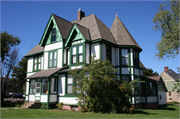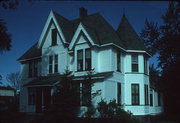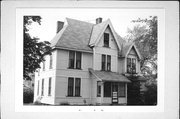Property Record
121 LAKE SHORE DR E
Architecture and History Inventory
| Historic Name: | DR. GEORGE AND IDA HARRISON HOUSE |
|---|---|
| Other Name: | |
| Contributing: | |
| Reference Number: | 688 |
| Location (Address): | 121 LAKE SHORE DR E |
|---|---|
| County: | Ashland |
| City: | Ashland |
| Township/Village: | |
| Unincorporated Community: | |
| Town: | |
| Range: | |
| Direction: | |
| Section: | |
| Quarter Section: | |
| Quarter/Quarter Section: |
| Year Built: | 1885 |
|---|---|
| Additions: | |
| Survey Date: | 19822016 |
| Historic Use: | house |
| Architectural Style: | Queen Anne |
| Structural System: | |
| Wall Material: | Clapboard |
| Architect: | Palliser and Palliser |
| Other Buildings On Site: | |
| Demolished?: | Yes |
| Demolished Date: | 2019 |
| National/State Register Listing Name: | Not listed |
|---|---|
| National Register Listing Date: | |
| State Register Listing Date: |
| Additional Information: | 1982 DESCRIPTION: This large and well preserved 1885 Stick Style fourteen room residence consists of a picturesque silhouette due to the tall central hip roof pierced by numerous projections that include two gabled front bays, the taller of which stands over the Front Street entry, which once had an elaborate Eastlake Style veranda. The northeast facade features a polygonal turret with prominent stickwork and decorative panelling. The original clapboard siding is in excellent repair and features exposed structural stickwork so typical of the style. The gables on the front side have richly carved bargeboards with applied ornament of the Eastlake style. The front gable is covered with fish scale shingles. The house rests on a brownstone foundation and all the original rectangular windows are intact. The interior is in excellent condition and is one of the finest examples of Eastlake style interior woodwork surveyed in Ashland. Door jambs and window moldings made of pine are fluted and have been stained a rich cherry wood color. The front hall is dominated by a grand staircase decorated with a balustrade of turned spindles with a newell post with grotesques. Two imported grand fireplace mantels with beautiful ceramic tiles (probably English) are in fine condition in the front parlor and entry hall. The dining room includes a bay window with wainscoting, a corner cupboard and a butler's pantry. Much of the antique furniture is original to the house and is styled in the Eastlake manner. It is possible that much of this furniture was locally made. One room downstairs has original parquet flooring. The 1885 George W. Harrison House is the best surviving example of Stick Style residential architecture, whose integrity of interior and exterior is unsurpassed. The house is the best building associated with Dr. George W. Harrison I, a prominent citizen of Ashland who later became Mayor of Ashland. HISTORICAL STATEMENT: George W. Harrison was ranked in importance to Ashland's development equally with Whittlesdy Beaser, Roehm, Bardon, Vaughn Knight and others. He was the son of the original Whittlesey Beaser, and both were recognized as fine physicians. The elder Harrison was prominent in Ashland's early years who was not only a doctor, but also sered as mayor, operated the street car company, and owned one of Ashlaned's first automobiles. The Harrison family, now beginning is fourth generatio in Ashland, still live in the George W. Harrison home. HISTORICAL STATEMENT ADDITION: George Harrison I was born in England in 1850 and moved to America with his parents shortly thereafter, settling in Columbus, Wisconsin and moved to Ashland in 1881. He studied medicine of Rush College in Chicago with Robert W. Earll, beginning in 1876 and graduated in 1881. Dr. Harrison was the second Mayor of Ashland and was sent to England by the city council to try to attract industry for Ashland. He managed the Ashland Street Railway Company for years. George Harrison II (1885-1934) carried on the family medical tradition. He was born in Ashland where he grew up and attended medical school at the University of Illinois. The Harrison house is a pattern book house, built from designs published by George and Charles Palliser of Bridgeport, Conn. The house appers in Palliser's American Cottage Homes, published in 1878 as plate 30. The design is very faithfully executed. 2016: No immediately apparent exterior alterations aside from a wooden porch deck off the rear to the west. 2017 report write-up: Rising from a cut brownstone foundation, this two-and-one-half-story, Stick Style house is sheathed with clapboard and includes horizontal banding. The asphalt-shingle roof consists of a tall, central, hipped core from which several gables extend. The home’s (south) entrance elevation is situated within an enclosed shed-roof porch. Above the porch, a pair of modest gabled projections features rich ornamentation including carved wooden bargeboards and decorative shinglework. The east elevation is dominated by a two-story, polygonal bay that is topped with a tent roof, while a two-story, gabled wing projects to the north (rear) and includes an enclosed, shed-roof porch. Fenestration throughout the house consists of a variety of two-over-two-light and other multiple-light sash with plain wooden surrounds. A modern wooden porch deck extends from the west side of the house. The subject house was built by Dr. George W. and Ida Harrison and completed in 1885. Dr. Harrison was born in Oldham, Lancashire, England, and he immigrated to the United States in 1859 at the age of nine. In 1871, he wed Ida Woodhead. He graduated in 1880 from Rush Medical College in Chicago and moved to Ashland that same year. In July 1883, Harrison purchased the three lots on what was then known as Front Street and, shortly thereafter, commenced construction of the subject house. George and Ida raised five sons in the house. In addition to his daily work as a physician (as well as operating the Harrison Pharmacy), George was also very active in the community and was among the incorporators of the Ashland National Bank (the board upon which he sat until his death), as well as the Ashland, Light, Power and Street Railway Company, for which served as president and general manager. Following Ashland’s 1887 incorporation as a city, Harrison also served as the city’s second mayor (from 1888-1889). Harrison died in 1905 and Ida remained in the subject home, with their son George (also a physician) and his family, until her death in 1924. Following George II and (his wife) Virginia’s deaths in 1934 and 1953, respectively, the house would pass on to grandson George Harrison and his wife Agnes. George III died in 1960 and Agnes remained in the home until at least 1990; she died in 2012. |
|---|---|
| Bibliographic References: | 1982: [A] ASHLAND DAILY PRESS, 1/13/05 [C] MRS AGNES HARRISON, CURRENTOWNER Palliser's American Cottage Homes, Bridgeport Conn: Palliser and Palliser, 1878, plate 30. 2017 report citations for information in Additional Comments below: Although an interior inspection was not completed as part of this survey or as a result of the earlier 2001 survey report, it is believed that the interior continues to retain a total of fourteen rooms and it remains as one of Ashland’s finest examples of Eastlake-style interior woodwork, including decorative moldings, an elaborate front hall staircase, as well as parquet flooring. History of Northern Wisconsin (1881), 72; Ferdinand Schupp and wife to George Harrison, WD (14 July 1883), 13/89; George Harrison, Obituary, The Ashland Daily Press, 13 January 1905, 1; Commemorative and Biographical Record of the Upper Lake Region (1905) page 239-240; death dates for all the remaining Harrison family gleaned from “U.S., Find-A-Grave Index, 1600s-Current,” Accessed June 2017; U.S. Federal Census, Population, 1900, 1910, 1920, 1930, 1940. |
| Wisconsin Architecture and History Inventory, State Historic Preservation Office, Wisconsin Historical Society, Madison, Wisconsin |





